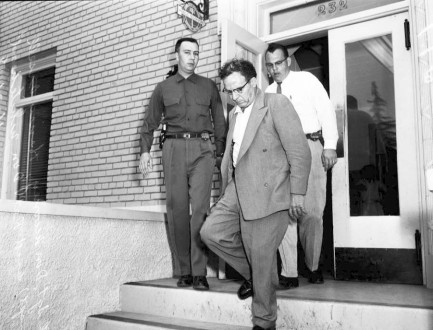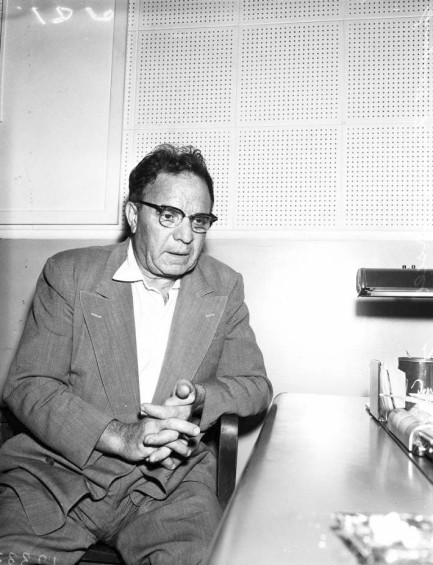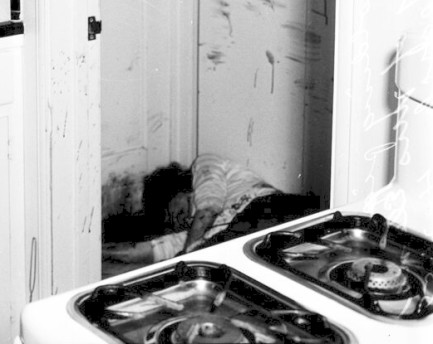 The L.A. dead get a voiceover. 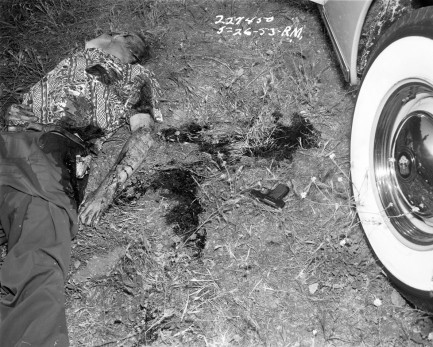
This photo which was made by an LAPD crime scene photographer today in 1953 seems to show a murder victim, but the subject actually committed suicide. We guess that's self-murder, but whatever, it's an amazingly chaotic result. While it's from the LAPD archvies, it was included in James Ellroy's 2015 photo retrospective LAPD '53. We have a copy and it's worth a look for fans of the macabre. There isn't much information on the photos—mostly they say merely “dead body” or “crime scene.” Ellroy instead discusses his own literary output, opines about film noir, shares anecdotes and musings about various Hollywood figures, recounts episodes from his youth, and occasionally lets himself be pulled down dark time warps he describes as “magical memory.” A typical example is his imaginary story of being at L.A.'s Club Alabam.
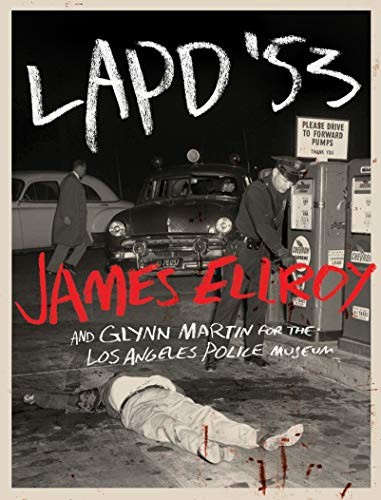 Charlie “Yardbird” Parker is bleating, blatting, honking and hiccuping “A Night in Tunisia.” Reefer smoke hangs humid. The music is decadently discordant. It’s the sock-it-to-me sonics of interminable chord changes off a recognizable main theme. It’s music for cultured cognoscenti that Bill Parker [LAPD Chief at the time] cannot acknowledge. Charlie “Yardbird” Parker is bleating, blatting, honking and hiccuping “A Night in Tunisia.” Reefer smoke hangs humid. The music is decadently discordant. It’s the sock-it-to-me sonics of interminable chord changes off a recognizable main theme. It’s music for cultured cognoscenti that Bill Parker [LAPD Chief at the time] cannot acknowledge.
It takes brains and patience to groove the gist of this shit. It’s the musical equivalent of the chaos Bill Parker deplores. Five-year-old Ellroy is there, watching the Bird take flight. Everybody’s chain-smoking unfiltered Camels. The place is one big corroded iron lung. I’ve got a spike in my arm, I’m orbiting on Big “H,” I knew I’d write the text for this book one day, so I’ve got my voyeur’s cap on.
Interesting, no? Ellroy's writing these days resides permanently on a razor's edge, as he ties together crime, politics, and alpha male ultraviolence. He seem to us the perfect transgressive guide for LAPD '53's tour through disaster and death for two reasons. First, he isn't just an observer—he was a one-man terror show in his own right, engaging in petty crime through his youth, joining the American Nazi Party in high school, and generally leaving chaos in his wake. He waves this period away as a cry for attention. His fame and teflon persona have facilitated this dismissal, and that's the second reason he's a good choice for the book: other people pay dearly for indiscretions far less severe, like the universe has played a terrible joke on them. Ellroy's fiction has always explored such cosmic inexplicability. He makes LAPD '53 an experience.
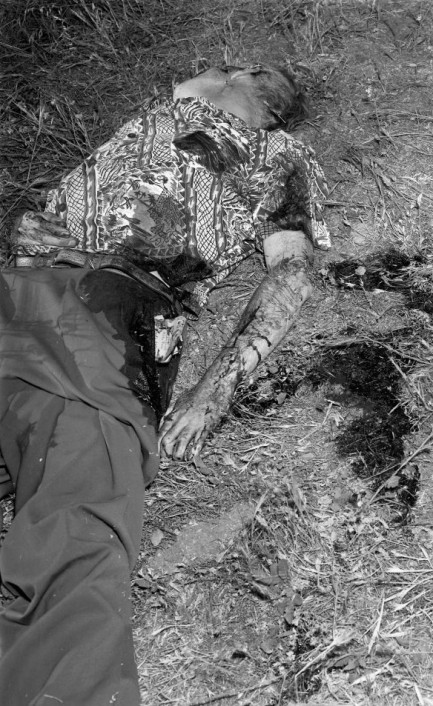
 Take a picture, perv. It'll last longer. 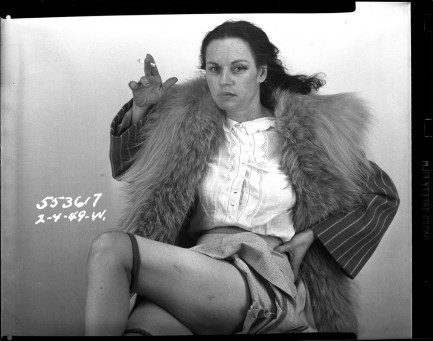 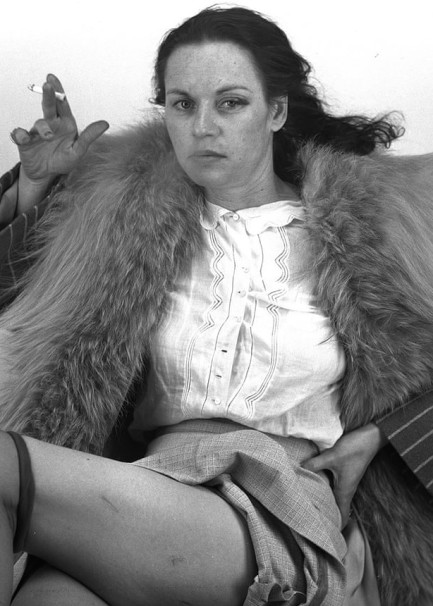
Above is another striking image from the 2019 Lucie Foundation exhibit of Los Angeles crime photos, most of which have been widely disseminated across the internet since then. That means we can always grab one when we want to dip into the mid-century crime underworld. The subject here, with her unfliching gaze and lit cigarette, has been arrested but there's no info revealing why. We're thinking public check and pinstripe clashing? No, probably not that. Imitating Sharon Stone in Basic Instinct? No, that was before her time. Felony cruelty to fur-bearing mammals? No. Okay, here's a shot in the dark—probably she was arrested for prostitution. That's our final guess. The photo was made today in 1949.
 You’re nobody ’til somebody loves you. 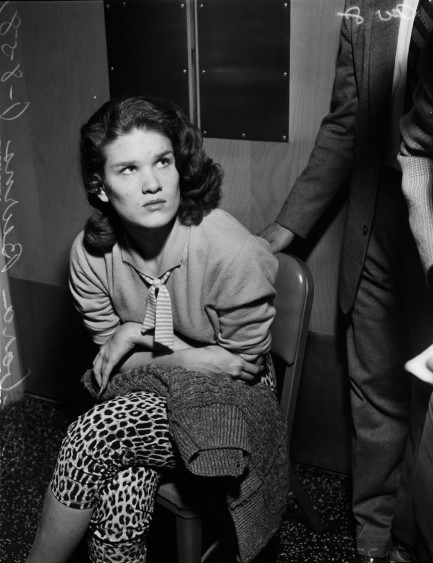 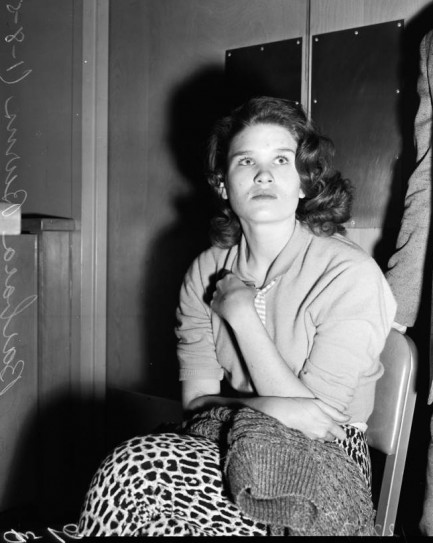
The above photos show Barbara Burns when she was busted for drugs today in 1958 after LAPD officers found track marks on her arms. Burns was the well-to-do daughter of famed comedian Bob Burns, but her father had died of kidney cancer in 1956. Barbara Burns was sentenced to probation after the arrest, and the story got some play in national newspapers, with several calling her probation sentence a storybook opportunity at a second chance. But she didn’t cooperate in the role. She managed to cobble together some behind-the-cameras television work, but was arrested for heroin possession in 1959. That time she served ninety days in jail and admitted in an interview, “I’m really hooked. I had nothing else to do, and my mother wouldn’t talk to me. I wanted to be a singer but I was too heavy and they told me it would help me lose weight.” Burns had always called herself an ugly duckling, compared herself unfavorably to her siblings, and felt she could never live up to family expectations. But even though her own words told the world that low self esteem was the root of her problems, a dead father and an estrangement from her mother probably didn't help things. The downward spiral continued. She was arrested for marijuana possession in early 1960 and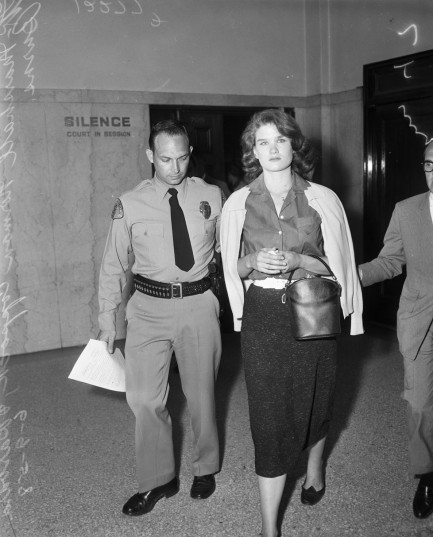 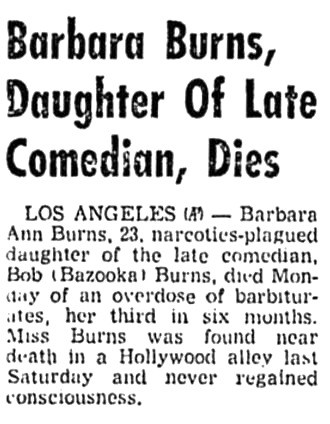 earned ninety days in Camarillo State Hospital. In November 1960 she was snared in another weed bust, but that time she walked after a jury acquitted her. When she was arrested for heroin possession again in June 1961, she lamented what had probably been true for longer than she admitted—that she had doomed her chance to have a career in show business. earned ninety days in Camarillo State Hospital. In November 1960 she was snared in another weed bust, but that time she walked after a jury acquitted her. When she was arrested for heroin possession again in June 1961, she lamented what had probably been true for longer than she admitted—that she had doomed her chance to have a career in show business.
At some point she sought medical treatment for an eye problem and was told by a doctor that she was losing her vision in her right eye. In both August and September of 1961 she attempted suicide, and in January 1962 while awaiting trial on one of her narcotics busts she was found overdosed and unconscious on a Hollywood street, and died a few days later in the hospital. Her suicide note said all she wanted was to be loved but everyone hated her. Many of her obituaries, ironically, described her as “tall and beautiful,” which she certainly would not have believed. They also noted her advantages in life—how she had won the crucial lottery of being born to wealth. But Barbara Burns didn’t see it that way. She once said, “I wish I had been born in some poor, obscure family that nobody knew. Then maybe I would have tried to become somebody.”
 Life to draws to a close in the City of Angels. 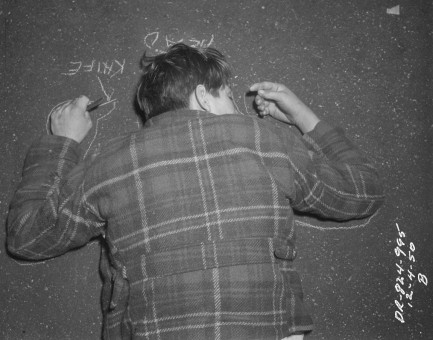
This photo, which is another one from the Los Angeles Police Department photo archive, shows an unidentified man after police crime scene detectives have outlined his body in chalk. Note the knife. He defended himself against an attacker, but unsuccessfully. Or perhaps he attacked someone and they defended themself successfully. The photos from the archive carry only the information written on them, and in this case that's nothing. But it's a compelling shot, made today in 1950.
 He was an innocent bystander. The stander part doesn't apply anymore. 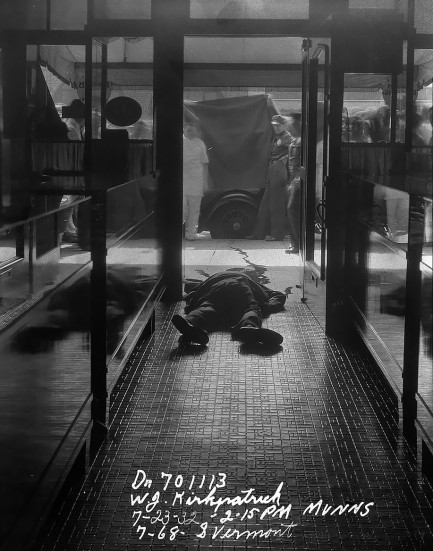 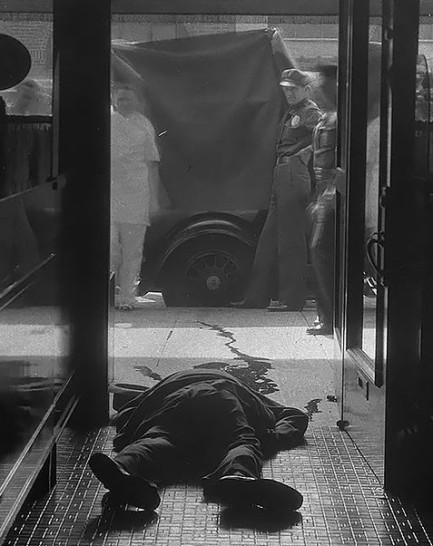
The only information accompanying the above image, which is from the Los Angeles Police Department photo archive, is that an unidentified bystander was shot to death during a botched jewelry store robbery. That was today in 1932. The photo came to public notice when it was exhibited back in 2019 by L.A.'s Lucie Foundation, along with more than 80 other images.
 Automobile fatalities in L.A. increase by one. 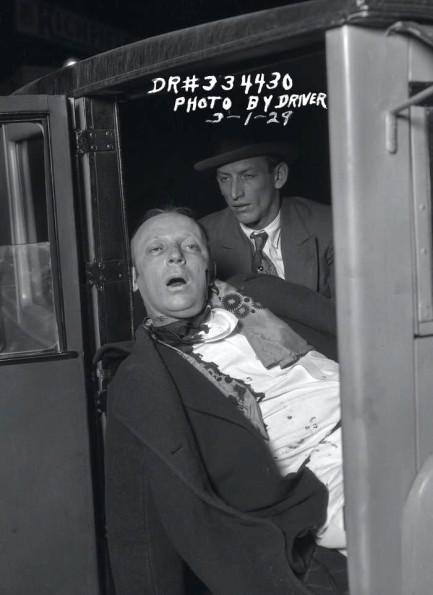
This macabre image, which showed up online a while back thanks to an exhibit of one hundred years of Los Angeles Police Department photos, shows an LAPD detective regarding a muder victim whose throat was cut while he was in his automobile. There's no information about who the victim was or why it happened, but it's an arresting image of a grisly end. The shot was made by Leon Driver, who when he arrived in L.A. from Texas in the early twenties was arrested for vagarancy, but by 1925 was one of the earliest official photographers employed the LAPD. He made this photo today in 1929.
 A ghost of Christmas past. 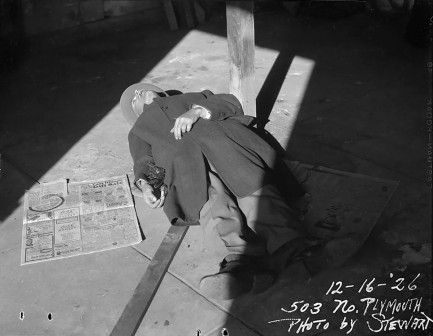
Just in case the holiday season was putting you in too upbeat of a mood, above is a dead guy for you. Nice of us, right? As the notation at the lower right of the photo indicates, this poor fella was found today in 1926, and documented by a police photographer named Stewart. This was in Los Angeles, at 503 North Plymouth, which is right in the heart of town not far from the Wilshire Country Club and Hollywood Memorial Park Cemetery (now known as Hollywood Forever Cemetery, where movies are shown on summer weekend nights, projected onto the side of a mausoleum). The body has a gun in its hand, but loosely. We thought we'd find a police report indicating whether this was suicide or a staged murder, but sadly this person vanished nameless into the snowdrifts of history. The photo first popped up in public because it was part of an exhibition called To Protect And Serve: The LAPD Archives, which was put together by two Los Angeles art gallery owners back in 2001. Before that it had been part of a trove of images found in a warehouse by the same two gallerists, and had previously been held by the LAPD’s Scientific Investigations Division, which was formed in 1924 and eventually accumulated close to a million images. The photo has now appeared in numerous exhibits in the U.S. and Europe, and been reproduced online countless times, but usually without context, which is why we're explaining its provenance. Let it be a reminder that this really is the season to be jolly—because you're alive, and that's a priceless gift. 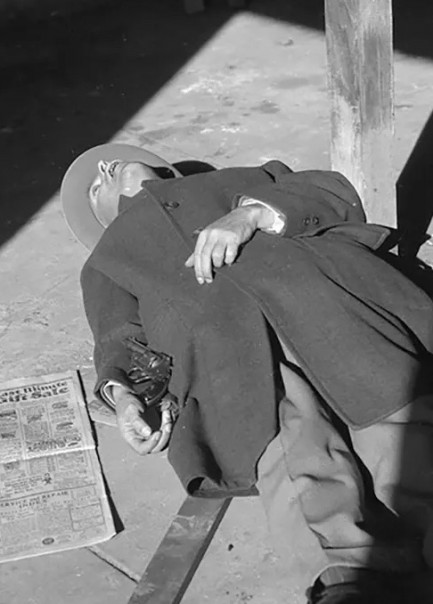
 They may have been in the winter of their years but their tempers still ran hot. 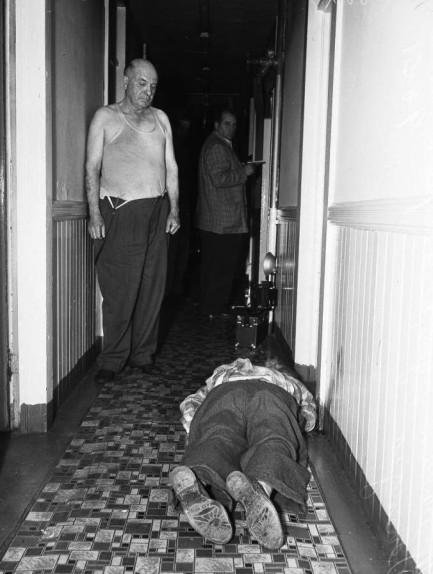 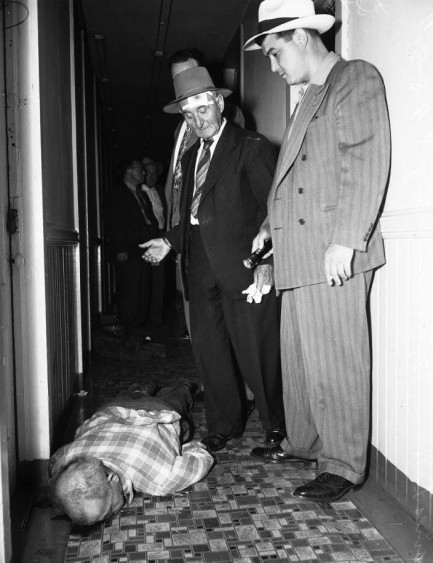 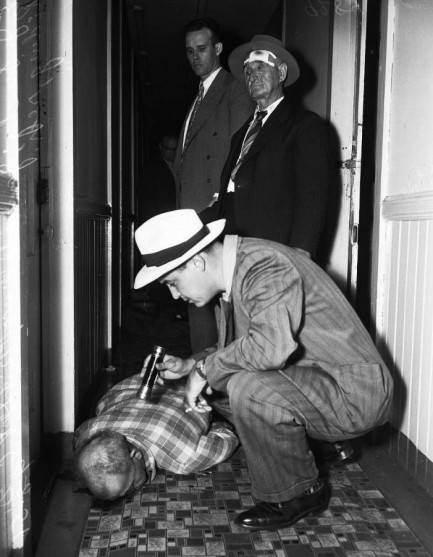 
Courtesy of the University of Southern California's archive of Los Angeles Herald and Los Angeles Examiner photos, above you see the aftermath of yet another violent act. This happened in a boarding house on Second Street today in 1951, and you see prone murder victim Enrico Venencia with neighbor David Dyer in the first shot, the killer James Demarco accompanied by LAPD detectives in frames two and three, and Demarco handcuffed to a bed in frame four, looking every day of his seventy-two years, and a little battered besides. But this is one situation where age prevailed. There's no information with the photos about what exactly happened. There isn't even a cause of death. The only information, besides the names of those involved, is that Dyer was an intended victim. That's how we were able to discern who was who—Dyer must be the one who isn't dead, and isn't handcuffed. We're not ballistics experts, but these archive images can be blown up to about 9000 pixels, and taking a close look it seems as if Venencia was possibly shot behind his left ear, suffered a gaping exit wound in the front of his skull, and went down hard. What an ugly way to go. 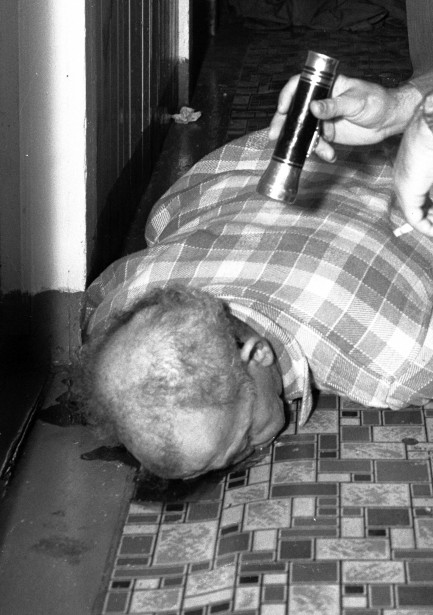
 As far as I'm concerned whoever let the cops in should pay all our legal fees. 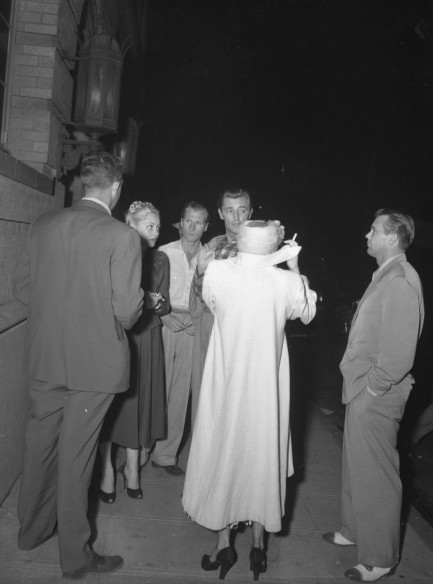
On this day in 1949, during the wee small hours of the morning, Robert Mitchum, Lila Leeds, Robin Ford, and Vickie Evans were hanging in a secluded Hollywood Hills home smoking a little mota when there was a scratch at the door. The house was the residence of Leeds and Evans, and it had become a spot where people, including Hollywood showbiz types, occasionally partook of the Devil's weed. By some accounts entry could be gained only via a secret knock, which—actually this is pretty clever—was to scratch at the front door like a cat. Since police had been tipped to the house's possible purpose, we can assume they too scratched at the door. We like to think they meowed too, but that probably didn't happen.
Anyway, Evans answered the door, and to her shock and dismay, in barged the police. Evans, Leeds, Mitchum, and Ford were corralled and escorted to the police station—and right into the cameras of the waiting press. The quartet are seen above with their legal representatives. Below, Mitchum, Leeds, and Ford are facing the camera, while Evans is facing away. Mitchum actually thought his career was ruined, but after being convicted of conspiracy to possess marijuana and serving sixty days in jail he continued as a top rank star. The up and coming Leeds, on the other hand, really was ruined by her conviction—at least according to her. Ford, who was a realtor, was also convicted, but we have no idea what happened to him afterward. Only aspiring dancer Evans was acquitted.
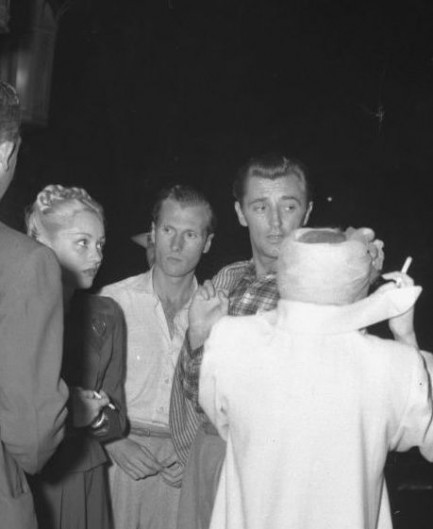

|
 |

The headlines that mattered yesteryear.
2003—Hope Dies
Film legend Bob Hope dies of pneumonia two months after celebrating his 100th birthday. 1945—Churchill Given the Sack
In spite of admiring Winston Churchill as a great wartime leader, Britons elect
Clement Attlee the nation's new prime minister in a sweeping victory for the Labour Party over the Conservatives. 1952—Evita Peron Dies
Eva Duarte de Peron, aka Evita, wife of the president of the Argentine Republic, dies from cancer at age 33. Evita had brought the working classes into a position of political power never witnessed before, but was hated by the nation's powerful military class. She is lain to rest in Milan, Italy in a secret grave under a nun's name, but is eventually returned to Argentina for reburial beside her husband in 1974. 1943—Mussolini Calls It Quits
Italian dictator Benito Mussolini steps down as head of the armed forces and the government. It soon becomes clear that Il Duce did not relinquish power voluntarily, but was forced to resign after former Fascist colleagues turned against him. He is later installed by Germany as leader of the Italian Social Republic in the north of the country, but is killed by partisans in 1945.
|

|
|

It's easy. We have an uploader that makes it a snap. Use it to submit your art, text, header, and subhead. Your post can be funny, serious, or anything in between, as long as it's vintage pulp. You'll get a byline and experience the fleeting pride of free authorship. We'll edit your post for typos, but the rest is up to you. Click here to give us your best shot.

|
|


 Charlie “Yardbird” Parker is bleating, blatting, honking and hiccuping “A Night in Tunisia.” Reefer smoke hangs humid. The music is decadently discordant. It’s the sock-it-to-me sonics of interminable chord changes off a recognizable main theme. It’s music for cultured cognoscenti that Bill Parker [LAPD Chief at the time] cannot acknowledge.
Charlie “Yardbird” Parker is bleating, blatting, honking and hiccuping “A Night in Tunisia.” Reefer smoke hangs humid. The music is decadently discordant. It’s the sock-it-to-me sonics of interminable chord changes off a recognizable main theme. It’s music for cultured cognoscenti that Bill Parker [LAPD Chief at the time] cannot acknowledge.







 earned ninety days in Camarillo State Hospital. In November 1960 she was snared in another weed bust, but that time she walked after a jury acquitted her. When she was arrested for heroin possession again in June 1961, she lamented what had probably been true for longer than she admitted—that she had doomed her chance to have a career in show business.
earned ninety days in Camarillo State Hospital. In November 1960 she was snared in another weed bust, but that time she walked after a jury acquitted her. When she was arrested for heroin possession again in June 1961, she lamented what had probably been true for longer than she admitted—that she had doomed her chance to have a career in show business.





